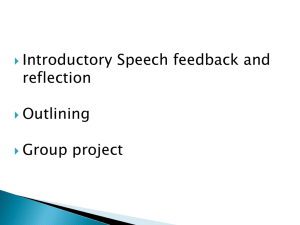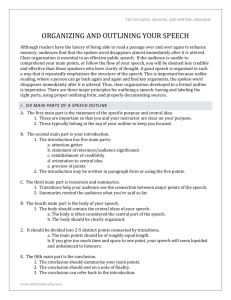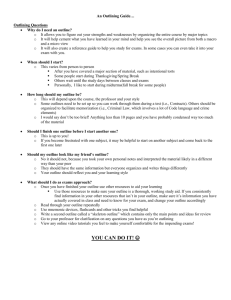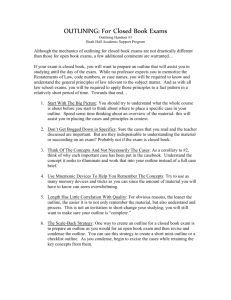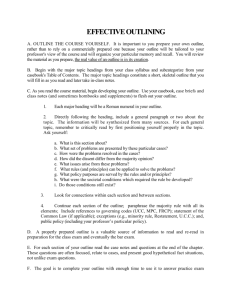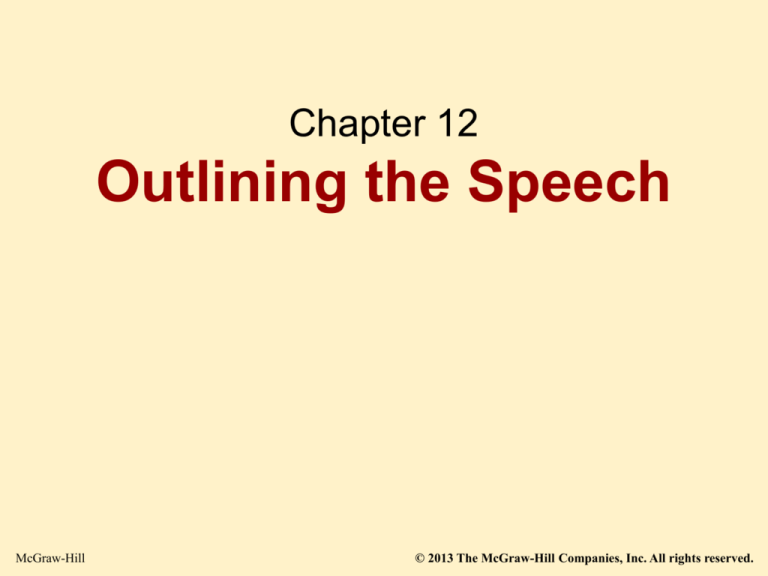
Chapter 12
Outlining the Speech
McGraw-Hill
© 2013 The McGraw-Hill Companies, Inc. All rights reserved.
Outlining
Blueprint = Outline
12-2
Outlining
• An aid for organizing
I. Eating disorders
A. Anorexia
B. Bulimia
12-3
Outlining
12-4
Outlining
• Why not write a word-for-word script
and use it to deliver a speech?
BORING
12-5
Outlining
• Advantages of an outline
An outline helps you see structure
and the relationship of ideas
An outline is streamlined
12-6
Outlining
• Follow three steps
Step 1: Create an outline
Step 2: Prepare speaking notes
Step 3: Deliver the speech
12-7
Outlining
Step 1: Create an outline
I. Guard against online thieves.
A. Install security software.
B. Shop only on secure Web sites.
C. Never open e-mail attachments
sent by strangers.
12-8
Outlining
Step 2: Prepare speaking notes
12-9
Outlining
Step 3: Deliver the speech
12-10
Outlining
• Why not use an outline while speaking?
Too many words
Temptation to read
12-11
Outlining
• How is outline different from actual speech?
Outline
Actual speech
I. Find definition of word quickly. If you want to know the definition
of a word quickly, use Google—
A. Search Google for word.
www.google.com—and search
B. Click on “definition.”
for the word. When the results
appear, you will see a bar at the
top of the page. It will display
your word and next to it the word
“definition” is underlined. Click
on “definition” and you will see a
full explanation of the word’s
meaning as well as synonyms.
12-12
Guidelines
12-13
Guidelines
• Chose an outline format
Topic
Complete-Sentence
I. Job hunting
A. Career counselor
B. Answering machine
C. Inform others
I. You can enhance your chances of
finding a job.
A. Consult a career counselor.
B. Invest in an answering machine to
record messages from prospective
employers.
C. Tell friends and colleagues to let
you know if they hear of good
possibilities.
12-14
Guidelines
• Use standard subdivisions
I.
A.
B.
1.
2.
a.
b.
II.
12-15
Guidelines
• Avoid single subdivisions
I.
WRONG:
A.
1.
2.
II.
12-16
Parts of the Outline
12-17
Title
General Purpose
Specific Purpose
Central Idea
Objectives
Introduction
Main points, with
transitions between
each main point
Transition
Body
Transition
Conclusion
Bibliography
Visual Aids
Documentation
12-18
Parts of the Outline
1. Title
2. Purposes and central idea
3. Introduction and conclusion
4. Body
12-19
Parts of the Outline
5. Transitions
6. Bibliography
7. Visual aids
12-20
Speaking Notes
12-21
Options for Notes
• Option 1: Use note cards
12-22
Options for Notes
12-23
Options for Notes
• Option 2: Use a full sheet of paper
12-24
Options for Notes
• Option 3: Use visual aids as prompts
12-25
Options for Notes
• Option 4: Use electronic devices
12-26
Controlling Your Material
12-27
Controlling Your Material
1. Revise outline and notes
whenever they need alterations
2. Test the outline
12-28
Controlling Your Material
3. Revise for continuity
4. Make deletions if you are in
danger of exceeding time limit
12-29
Tips for Your Career
12-30
Tip 12.1
When No Time Limit is Set,
Speak Briefly
Listeners love
brevity
12-31
Tip 12.2
Decide How You Will Reveal
Your Sources
“You say
orange juice
cures cancer.
What is your
source?”
12-32

